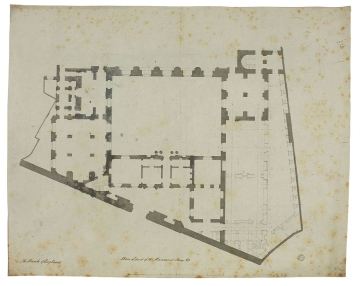
Browse
- Sir John Soane office drawings: the drawings of Sir John Soane and the office of Sir John Soane
Reference number
Purpose
Aspect
Scale
Inscribed
Medium and dimensions
Hand
Notes
The printing of bank notes had been contracted out to a London printer until 1791 when the process was moved onto the Bank's premises, setting up in an office over the Barracks (see Barracks and Bank Note Printing Office scheme). Despite working on site, the printer operated independently and under the only occassional supervision of a Bank clerk. The advent of 1 and 2 pound banknotes in 1797 greatly increased the printers' duties, from three employees in 1792 to twenty in 1800, and with eighteen presses in use (Mackenzie, p.40). The charcoal fumes heating the copper plates were causing illness within the confined rooms and the Bank's chief printer, Garnet Terry, repeatedly requested more space (Mackenzie, p.44). In March 1808 the new Printing Offices were finally finished. The handpresses had been replaced by machines, a faster and healthier alternative, and were housed in long rooms with windows on either side.
Literature
Level
Sir John Soane's collection includes some 30,000 architectural, design and topographical drawings which is a very important resource for scholars worldwide. His was the first architect’s collection to attempt to preserve the best in design for the architectural profession in the future, and it did so by assembling as exemplars surviving drawings by great Renaissance masters and by the leading architects in Britain in the 17th and 18th centuries and his near contemporaries such as Sir William Chambers, Robert Adam and George Dance the Younger. These drawings sit side by side with 9,000 drawings in Soane’s own hand or those of the pupils in his office, covering his early work as a student, his time in Italy and the drawings produced in the course of his architectural practice from 1780 until the 1830s.
Browse (via the vertical menu to the left) and search results for Drawings include a mixture of Concise catalogue records – drawn from an outline list of the collection – and fuller records where drawings have been catalogued in more detail (an ongoing process).

